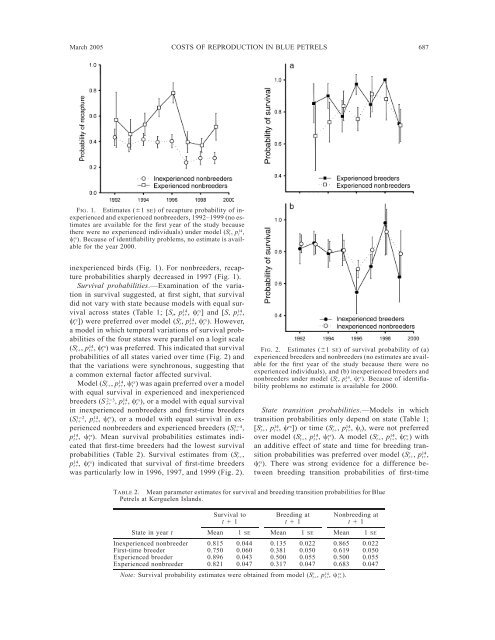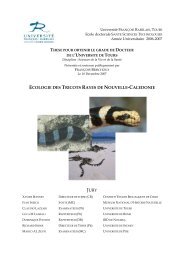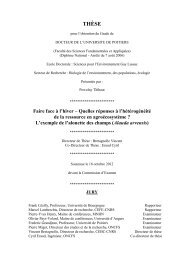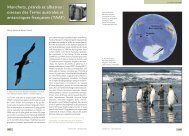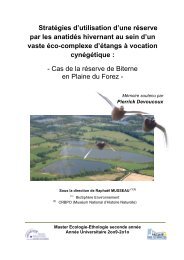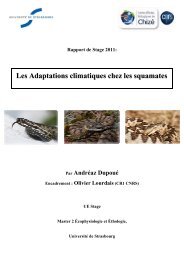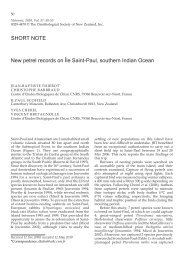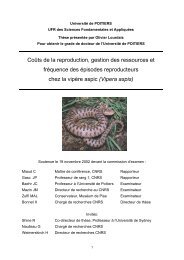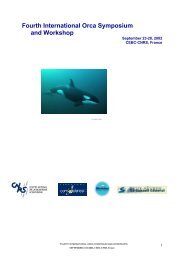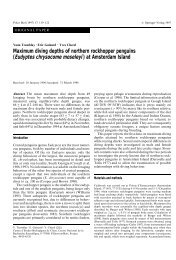Forçage environnemental et prédateurs marins ... - Cebc - CNRS
Forçage environnemental et prédateurs marins ... - Cebc - CNRS
Forçage environnemental et prédateurs marins ... - Cebc - CNRS
You also want an ePaper? Increase the reach of your titles
YUMPU automatically turns print PDFs into web optimized ePapers that Google loves.
March 2005 COSTS OF REPRODUCTION IN BLUE PETRELS<br />
687<br />
FIG. 1. Estimates (1 SE) of recapture probability of inexperienced<br />
and experienced nonbreeders, 1992–1999 (no estimates<br />
are available for the first year of the study because<br />
there were no experienced individuals) under model ( Sr, 14<br />
t pt<br />
,<br />
rs t ). Because of identifiability problems, no estimate is avail-<br />
able for the year 2000.<br />
inexperienced birds (Fig. 1). For nonbreeders, recapture<br />
probabilities sharply decreased in 1997 (Fig. 1).<br />
Survival probabilities.—Examination of the variation<br />
in survival suggested, at first sight, that survival<br />
did not vary with state because models with equal survival<br />
across states (Table 1; [St, p14, rs] and [S, 14<br />
t t pt,<br />
rs]) were preferred over model ( r, 14, rs<br />
t St ptt). However,<br />
a model in which temporal variations of survival probabilities<br />
of the four states were parallel on a logit scale<br />
( Sr, p14, rs)<br />
was preferred. This indicated that survival<br />
t t t<br />
probabilities of all states varied over time (Fig. 2) and<br />
that the variations were synchronous, suggesting that<br />
a common external factor affected survival.<br />
Model ( Sr, 14, rs<br />
t ptt) was again preferred over a model<br />
with equal survival in experienced and inexperienced<br />
breeders ( S 23, 14, rs<br />
t ptt), or a model with equal survival<br />
in inexperienced nonbreeders and first-time breeders<br />
( S12, 14, rs<br />
t ptt), or a model with equal survival in experienced<br />
nonbreeders and experienced breeders ( S34 t ,<br />
p14, rs).<br />
Mean survival probabilities estimates indi-<br />
t t<br />
cated that first-time breeders had the lowest survival<br />
probabilities (Table 2). Survival estimates from ( r ,<br />
p14, rs<br />
t t<br />
) indicated that survival of first-time breeders<br />
was particularly low in 1996, 1997, and 1999 (Fig. 2).<br />
FIG. 2. Estimates (1 SE) of survival probability of (a)<br />
experienced breeders and nonbreeders (no estimates are available<br />
for the first year of the study because there were no<br />
experienced individuals), and (b) inexperienced breeders and<br />
nonbreeders under model ( Sr, 14, rs<br />
t pt t<br />
). Because of identifia-<br />
bility problems no estimate is available for 2000.<br />
TABLE 2. Mean param<strong>et</strong>er estimates for survival and breeding transition probabilities for Blue<br />
P<strong>et</strong>rels at Kerguelen Islands.<br />
Survival to<br />
t 1<br />
Breeding at<br />
t 1<br />
Nonbreeding at<br />
t 1<br />
State in year t<br />
Mean 1 SE Mean 1 SE Mean 1 SE<br />
Inexperienced nonbreeder 0.815 0.044 0.135 0.022 0.865 0.022<br />
First-time breeder 0.750 0.060 0.381 0.050 0.619 0.050<br />
Experienced breeder 0.896 0.043 0.500 0.055 0.500 0.055<br />
Experienced nonbreeder 0.821 0.047 0.317 0.047 0.683 0.047<br />
r 14 rs<br />
Note: Survival probability estimates were obtained from model (S t, p t, t).<br />
S t<br />
State transition probabilities.—Models in which<br />
transition probabilities only depend on state (Table 1;<br />
[ , , rs Sr 14 ]) or time ( r , 14<br />
t pt Stpt, t), were not preferred<br />
over model ( Sr, 14, rs). A model ( r , 14, rs<br />
t ptt Stptt) with<br />
an additive effect of state and time for breeding transition<br />
probabilities was preferred over model ( Sr, 14<br />
t pt,<br />
rs t ). There was strong evidence for a difference be-<br />
tween breeding transition probabilities of first-time


